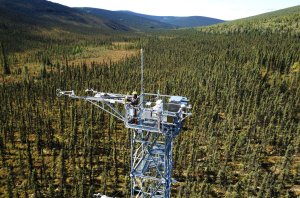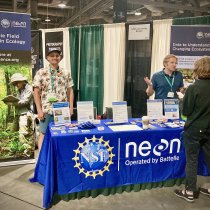Happy Earth Day! Let’s Science Together
April 21, 2020
Earth Day invites us all to consider our relationship with the planet and environment. What better time could there be to get involved in an ecology-focused citizen science project?
April 22, 2020, marks the 50th anniversary of Earth Day. Earth Day founder Gaylord Nelson envisioned the day as “a national teach-in on the environment.” Over the last several decades, the movement has continued to grow, and Earth Day is now marked by millions across the globe each April.
Earth Day reminds us that the earth and the environment belong to all of us—and everyone can get involved in observing, studying and protecting our ecological treasures. Citizen science projects offer opportunities for people of all ages, backgrounds and education levels to get involved in ecology and environmental science directly. The data gathered through these programs can complement and support the work being done by individual researchers and large-scale ecology observatories like the NEON program.
How Citizen Scientists Can Help Ecology Research
Ecology has a long tradition of citizen science. Field observations from self-taught naturalists and intrepid explorers shaped the field for generations. It is still one of the most accessible scientific fields for laypeople to get involved in and contribute to. All you need is a plot of nature (your backyard counts!), your senses, a notebook (or an app), and a field guide or observation protocol.
Katie Jones, a Plant Ecologist for the NEON program, says, “What I love about citizen science is that there are projects people can get involved in at all levels, from simple projects Kindergartners can engage with all the way to complex data collection efforts that draw in professional scientists. It really democratizes data collection.”
Donal O’Leary, a Data Science Educator for the NEON program, adds, “Citizen science has a tremendous utility for the scientific community. What I love about it is that it emphasizes science as something we all can do, not something that happens off in the mist somewhere. It brings people in and makes science an action.”
Participating in citizen science projects isn’t just fun and educational. The data gathered by citizen scientists adds real value to the science community. An army of observers in their own backyards and nearby parks can provide a breadth of coverage across the country that can’t be matched by academic researchers and large-scale observatories alone. Katie explains, “The NEON program generates high-resolution, high-frequency data at a limited number of sites. We have 81 sites across the country, but our coverage in absolute spatial terms is quite small when you consider the continent as a whole. Citizen science projects help fill in the gaps between sites. The data can tell scientists whether something observed at a NEON site is happening across larger geographic areas.”
Large, well-known citizen science projects like Nature’s Notebook and the Audubon Christmas Bird Count attract thousands or tens of thousands of participants with varying levels of skill and education. Because of this, individual observations may not have the same reliability and validity as the observations made by highly trained field ecologists—an individual observer may misidentify a bird or fail to apply the right observation protocol for a plant phenology study. But the power of citizen science lies in the sheer number of observations. With thousands or millions of individual observations, erroneous outlier data tends to be overwhelmed by the much larger number of correct data points from the crowd.
Overall, citizen scientists have been shown to be remarkably accurate in their observations. A 2014 study of Nature’s Notebook volunteers showed that volunteers with limited training were able to correctly identify phenophases (observable stages in the annual lifecycle of an organism) for 19 observed plant species 91% of the time. The study concluded that, “Overall, these results suggest that volunteers with limited training can provide reliable observations when following explicit, standardized protocols.”
Donal says, “We encourage everyone to give it a try. These projects tend to be very well documented and designed for people with little or no experience. Most people can identify a dandelion with a picture in front of them or read a rain gauge without formal training.”
Nature’s Notebook and NEON: A Marriage of Citizen Science and Large-Scale Ecology
The NEON program has contributed plant phenology data from 2013 through present to the USA National Phenology Network. These data relate to a NEON data product called ‘Plant Phenology Observations’ which is the quality controlled raw observations collected by human observers at terrestrial NEON sites. The USA-NPN ingests our raw data from the NEON data portal, and provides it alongside similar data through their Phenology Observation Portal. Their data, collected through Nature’s Notebook is named “Status and Intensity,” and is the same resolution as the NEON “Plant Phenology Observations” data product. Additionally, the NPN provides summary and derived data products in the form of their “Individual Phenometrics”, “Site Phenometrics” and “Magnitude Phenometrics” data types.
The NEON Plant Phenology Observations data product is one of 181 high quality and standardized data products collected by NEON, and it comprises approximately 12% of these data at the NPN. NEON data are available with those collected by citizens through the Nature’s Notebook citizen science project created and supported by the National Phenology Network (USA-NPN). Citizen scientists log observations about plant and animal phenophases—such as whether a plant is flowering, a bird is building a nest, or how many adult insects are flying—into the Nature’s Notebook app or upload data directly to the portal on the Nature's Notebook website. The website and app provide clear, explicit instructions and observational protocols that are easy for people of all experience levels to follow.
USA-NPN collects data from citizen scientists along with data from professional ecologists and scientific organizations in addition to NEON. The resulting database provides a rich source of information about species presence, absence and migration and the timing of key biological events for different species in different parts of the country. The citizen science data create a much more granular view of what is happening at a hyper-local level. These data can help researchers build better models of changes in species range, migration patterns and phenophase timing than is possible with the spatially limited data sets provided by the NEON program and other scientific organizations.
Donal explains, “Nature’s Notebook collects much more data over a much broader spatial range than we could ever do with our scientific team. This gives us data across the country and for different microhabitats where we are not observing. That allows us to create more robust models with a higher degree of accuracy.”
One example of the power of citizen science observations is the USA-NPN Status of Spring Map. These maps are built using spring leaf-out and spring bloom data collected for three species that are widely found in yards and parks nationwide: a cloned lilac cultivar (S. x chinensis, Red Rothomagensis) and two cloned honeysuckle cultivars (Lonicera tatarica, Arnold Red and L. korolkowii, Zabelii). Standardized data on these species collected by thousands of volunteers was used to develop a model that produces a highly granular data visualization of the progress of spring in different parts of the country. Comparing data over time provides insights into how climate change is changing the timing of spring events. NEON field teams use some of the temperature and spring index data products provided by NPN to help inform their sampling schedule. Over 100 peer reviewed articles have been published using USA-NPN data, including one written by a former NEON scientist that uses both NEON and NPN data, before the two datasets were merged.
The NEON data include detailed observations that are more frequent and use a coordinated standardized approach across sites. Species observed through the NEON program that have not been previously observed through Nature’s Notebook are added to their database. The NEON program also collects additional data sets that USA-NPN does not, such as meteorological data, vegetation cover and community composition, mammal and insect pathogen status, and carbon and nutrient exchange between vegetation and the atmosphere. These data allow a broader range of scientific questions to be asked, such as how changes in climate may be impacting species range and community composition or plant and animal phenology.
The NEON program has teamed up with USA-NPN to make NEON phenology data available through the USA-NPN Data Portal in addition to the NEON Data Portal. This enables researchers to explore NEON phenology data using USA-NPN’s data visualization tools.
More Citizen Science Projects for Earth Day and Every Day
Anyone interested in participating in the Nature’s Notebook phenology project can download the app from the Apple App or Google Play stores or sign up at naturesnotebook.org. Nature’s Notebook is a great gateway project for aspiring citizen scientists of all ages and backgrounds.
If phenology isn’t your interest, you can find hundreds of other citizen science projects at https://www.citizenscience.gov. Their catalog lists 448 citizen science projects that support the missions of different federal agencies and federally supported scientific programs. These projects range from national projects like the North American Breeding Bird Survey (collecting citizen science data since 1966!) and “Nurdle Patrol” (counting plastic pellets on beaches and in waterways) to local projects like Steller Sea Lion Watch in the Aleutian Islands and Air Pollution Monitoring in Chicago.
Many state and national parks and local universities have citizen science projects of their own to explore. Yellowstone National Park counts on citizen scientists for their beetle biodiversity project. The Community Snow Observations project recruits skiers and other winter recreationists to collect snow depth observations in mountainous regions.
Citizen science projects are a great way for individuals and families to celebrate Earth Day and Citizen Science Month—even while social distancing! Many of these projects can be completed in your own backyard or in nearby metro, state or national parks. Katie says, “We all make observations in the world every day. Citizen science projects provide an opportunity to share those observations and contribute to something bigger.”
Want to join the NEON program in observing our natural world? Sign up for Nature’s Notebook or find a citizen science project aligned with your interests and location at citizenscience.gov.

